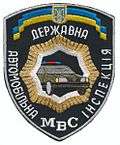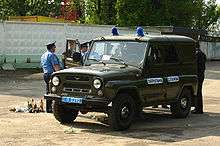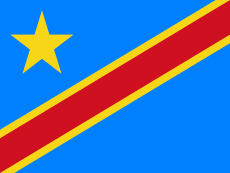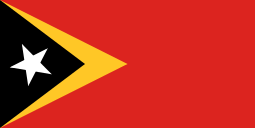Militsiya (Ukraine)
| Militsiya міліція | |
|---|---|
| Abbreviation | MVS (Ukrainian: МВС) |
|
Emblem of the MVS | |
| Agency overview | |
| Formed | 20 December, 1990 |
| Preceding agency | Soviet Militsiya |
| Dissolved | 7 November 2015[1] |
| Employees | 152,000 (October 2015)[2] |
| Legal personality | Governmental: Government agency |
| Jurisdictional structure | |
| National agency | Ukraine |
| Size | 603,500 km² |
| Population | 44 million (approx.) |
| Governing body | Government of Ukraine |
| General nature | |
| Operational structure | |
| Headquarters |
Kiev Ukraine |
| Parent agency | Ministry of Internal Affairs |
The militsiya (Ukrainian: міліція) was the national police service of Ukraine from the 1950s until 2015. The militsiya was formed whilst Ukraine was governed by the Ukrainian Soviet Socialist Republic, part of the Soviet Union, and continued to serve as a national police service in independent Ukraine until it was replaced by the National Police of Ukraine on 7 November 2015.[1][nb 1]
The agency was under direct control of the Ministry of Internal Affairs (known by the Ukrainian acronym MVS), and was widely seen as corrupt.[3]
History
Early history
On 2 February 1713, by order of Emperor Peter I, landmilitia were formed in Ukraine out of regiments of the Russian army quartered in Ukraine and specially recruited soldiers to carry out security and guard duties.[4] Since 1722 local cossacks were allowed to join landmilitia. In 1736 by the request of the great Russian military reformer General Field marshal Minikh the units of landmilitia were renamed into the Ukrainian Militia Corps that was accounted for 20 cavalry regiments.
Since 1762, when the Emperor Peter III ordered the corps to be called simply the Ukrainian, the word landmilitia fell out of use. In 1770 the Ukrainian Corps was merged with the Russian regular army, however, the special tax that was paid by the population of Ukraine for the landmilitia upkeep was liquidated only in the beginning of 19th century.
Militsiya in Soviet Ukraine
The contemporary Ministry of Internal Affairs of Ukraine originates from the Soviet NKVD's branch in Ukrainian SSR - the "NKVD of the UkrSSR", which was later reformed into the "Ministry of Internal Affairs of UkrSSR" (Ministerstvo vnutrishnikh sprav Ukrayins'koyi SSR). Both agencies were merely a regional branch of the all-Soviet Ministry of Internal Affairs, and essentially a militsiya force since the late 1950s.[5]
Despite some operational autonomy, all regulations and standards of policing were established by the central Ministry; Moscow was directly co-ordinating important operations in Ukraine (such as anti-corruption investigations regarding statesmen of higher levels or other politics-related issues), including deployment of detective brigades from central offices in case of need. TheMilitsiya of the Ukrainian SSR used the same ranks, insignia and vehicle liveries as the rest of the Soviet militsiya.
Like all the Soviet Ministries of Internal Affairs, the Ukrainian SSR MVS included not only the militsiya, but also the republican branch of non-police services, such as:
- Passport and registration offices
- Internal Troops and prison administration (including the Chief Directorate of Camps)[6]
- Fire and rescue service
Militsiya and political repression in Soviet Ukraine
MVS of the Ukrainian SSR has been directly involved in Soviet political repressions in Ukraine at all stages. Since the splitting of the NKVD and detachment of the secret police to the MGB-KGB, the militsiya became a secondary instrument of repression in the hands of the KGB, fulfilling such tasks as:
- conducting fabricated charges of non-political crimes against Ukrainian dissidents (like Vyacheslav Chornovil)
- tackling occasional mass protests against Soviet rule
- maintaining the propiska regime
- participation in ethnic-related repressions and restrictions
- assisting in the persecution of religion
- direct persecution of homosexuals and various restricted cultural movements (like rockers, punks, bikers, karate students etc.)
Militsiya in independent Ukraine

Post-Independence reformation and the Gongadze case
Since independence and before the 2004 Constitutional Reform, Ukraine's Minister of Internal Affairs was directly subordinate to the President of Ukraine (appointed by the President unilaterally), also a formal member of Ukraine's Cabinet of Ministers. Before the Orange Revolution, only militsiya Generals (not civil statesmen), were appointed Ministers.
The Ukrainian militsiya has a significant record of law violation and human rights abuse. The most notorious case is the agency's involvement in the murder of journalist Georgiy Gongadze in 2000. Soon after Gongadze's disappearance, recordings of a Major Melnychenko were revealed.
A fragment of the recorded conversations portrayed MVS Minister Kravchenko promising President Kuchma to "take care" of the oppositional journalist. According to the recordings, Kravchenko told Kuchma that he controls a special group of high-class detectives "without any morals, and ready to do anything".
The decapitated and disfigured body of Gongadze was found later in a forest, and a long-lasting investigation started. In 2005, soon after the Orange Revolution, the first results of the case appeared. Three members of the MVS detective squad were charged with the abduction and murder of Gongadze. An international warrant was issued for their chief, General Oleksiy Pukach, who was supposedly hiding abroad.[7]
In March 2005, ex-Minister Kravchenko, the main participant of the case, was found shot in the head (supposedly by his own hand). Later, in September 2010, Ukraine's Office of the Prosecutor General issued a statement stating that prosecutors had concluded that Kravchenko had ordered Pukach to carry out the murder, and stating that Pukach had confessed to the murder.[7]
In the Melnychen recordings, the hitmen group was called "orly" Ukrainian: орли (literally "eagles") by the Minister. (Orly here it is not a proper name, but a traditional Russian common name for brave and skilful soldiers). Since then, the phrase "Orly of Kravchenko", became a symbol of lawlessness and brutality in Ukrainian law enforcement.
MVS and the UBK campaign
In 2000-2001, the MVS was trying to tackle Ukraine without Kuchma (Ukrainian abbreviation: UBK) mass protest campaign against President Leonid Kuchma, using various methods: from direct attacks to the infiltration of provocateurs. The final confrontation took place on 9 March 2001 on the central streets of Kiev, including clashes between protesters and anti-riot units, and mass arrests of youngsters in the city.
MVS during the Orange Revolution and later years

During the 2004 election and the Orange Revolution, the MVS did not confront the opposition protests, although media sources claim that respective orders were given to its anti-riot units by senior commanders and leaders of the country. Minor clashes between protesters and the Berkut happened in the city of Chernihiv, but both sides agreed that they were incidental and provoked by unknown forces. The opposition also accused the militsiya of involvement in attempted electoral fraud that occurred at polling stations.
In February 2005, after the revolution, as part of the post-election democratic changes, President Viktor Yushchenko appointed Yuriy Lutsenko as the new Minister of Internal Affairs. Unlike his predecessors, Lutsenko was a career politician and had never served in the militsiya or any other law enforcement agency. Moreover, as one of the main figures in the Socialist Party of Ukraine, Lutsenko participated in several protest campaigns and conflicts with the militsiya. The new minister demanded resignations from those officers involved in racketeering. Thus, taking a significant step towards the establishment of civil control over the Ukrainian militia.
In January 2006, Minister Lutsenko admitted that the MVS is in possession of the evidence that would allow them to question and charge ex-President Leonid Kuchma in a privatisation wrongdoing case, if only the MVS had the authority for starting such a case autonomously. Later, according to 2004 constitutional amendments that took effect after the 2006 parliamentary elections, the minister is now nominated by the Prime Minister and appointed by the Verkhovna Rada (parliament), without formal influence of the President. Thus Yuriy Lutsenko, the Minister at the time, who was previously appointed under the old procedure, was reappointed, thereby becoming the first-ever MVS Minister to be agreed upon by the parliamentary coalition and appointed by parliament.
On 1 December 2006, Verkhovna Rada dismissed Lutsenko and appointed Vasyl Tsushko of the Socialist Party as the new Minister. Like his predecessor, Tsushko was also a civil politician (and previously a vineyard manager), not connected to the militsiya before his appointment. Additionally, Tsushko was the first-ever MVS Minister not subordinated to the President.
However, in 2007 Lutsenko returned to the post of minister and remained there until the elections which brought Viktor Yanukovich to power in 2010. After Yanukovich's election, Anatolii Mohyliov was appointed to the minister's position; he is a career militia officer and currently holds the rank of Colonel General of the militsiya. Vitaliy Zakharchenko succeeded him in November 2011.

In May 2007, the ongoing political crisis in Ukraine lead to a jurisdiction dispute over the country's Internal Troops. Following minor political clashes involving the militsiya and presidential security forces, President Viktor Yuschenko issued a decree re-subordinating Internal Troops from the Ministry of Internal Affairs directly to the President. The MVS criticised both the decree and the subsequent troop movements.
Both sides in the political crisis managed to avoid further clashes between law enforcers. Now the Internal Troops, as well as all militsiya units, returned to their routine tasks and re-established practical co-ordination. However, the legal dispute over Internal Troops remains unsolved. The Troops command declares its subordination to the President - according to the decree which is currently being appealed in court by the Cabinet of Ministers.
On 10 October 2008 officers from the Security Service of Ukraine detained deputy platoon commander of the Kharkiv city division patrol and inspection service regiment of the Main Interior Affairs Ministry Directorate in Kharkiv region on suspicion of pushing narcotic drugs.[8]
According to head of the trade union of attested employees of law enforcement agencies Anatolii Onyschuk, sociologic research shows that 3.9% of the Ukrainian militiamen trust the state, while 67.7% distrusted the state.[8]
2015 disbandment
Following reforms initiated by Ukrainian president Petro Poroshenko in the aftermath of the 2014 Ukrainian revolution, on 3 July 2015 the National Police of Ukraine started to replace militsiya.[3] Officially the National Police replaced the militsiya on 7 November 2015.[1] On that day the remaining militsiya officers where assigned as "temporarily acting" National Police officers.[1] They were eligible for recruitment as National Police officers if they met the age criteria and went through training again and after "integrity" checks.[1][9]
Departments
The following were the constituent departments of the militsiya:
- Leadership (consisting of the minister and his first deputy)
- Office of Ministry (Department in monitoring of human rights in activities of OVS)
- Advisers to the MVS
- Deputy Minister - Chief of HUBOZ
- Chief Department in the fight against the organised crime (HUBOZ)
- Internal Security Service of HUBOZ
- Deputy Minister - Chief of Criminal Militsiya (consists of at least nine subordinated departments)
- Deputy Minister - Chief of Militsiya of Civil Security
- Department of Civil Security
- Department of the State Auto Inspection (DAI)
- Department of Veterinary Militsiya in conducting quarantine in veterinary events
- Department of State Security Service (formerly part of Militsiya of civil security, it is currently a separate department)
- Department of transportation militsiya
- Deputy Minister - Chief of HSU
- Chief Detection Department
- Department of Investigation (Inquiry)
- State Science-Research Expert-Criminal Center
- Deputy Minister - Chief of Staff (several independent departments and directorates which are primarily for administrative support)
- Deputy Minister
- Department of public relationship and international activity
- State Department on issues of citizenship, immigration, and registration of physical persons
- Deputy Minister
- Supporting departments
- Deputy Minister - Chief of MVS in Crimea
| Branch | Criminal | Traffic | Public Order | State Security Service |
| Insignia |  |  |  | .jpg) |
Rank hierarchy
| Cadet Officers | Private Officers | Non-commissioned Officers | ||||||
|---|---|---|---|---|---|---|---|---|
| Shoulder insignia for every day uniform |
|
|
|
|
|
|
|
|
| Rank | Cadet of militsiya |
Private of militsiya |
Junior sergeant of militsiya |
Sergeant of militsiya |
Senior sergeant of militsiya |
Starshina of militsiya |
Praporshchik of militsiya |
Senior praporshchik of militsiya |
| Junior Commissioned Officers | Senior Commissioned Officers | General Officers | |||||||||
|---|---|---|---|---|---|---|---|---|---|---|---|
| Shoulder insignia for every day uniform |
|
|
|
|
|
|
|
|
|
| |
| Rank | Junior lieutenant of militsiya |
Lieutenant of militsiya |
Senior lieutenant of militsiya |
Captain of militsiya |
Major of militsiya |
Lieutenant colonel of militsiya |
Colonel of militsiya |
Major General of militsiya |
Lieutenant General of militsiya |
Colonel General of militsiya | |
Service medals
-
.png)
25 years in service
-
20 years in service
-
15 years in service
-
10 years in service
Transport

The militsiya used many different forms of transport, which ranged greatly in age and technical specification.
Patrol fleet at disbandment
Patrol cars |
Vans |
SUVs |
-
Skoda Octavia road police car
-
Mitsubishi Lancer police car
-

Toyota Camry police car
-

Older UAZ-469 police SUV
-
_-_1.jpg)
Renault Duster police SUV
-
Kia Pregio police van
-
Renault Kangoo police car
-

GAZ Sobol police van
Deployment outside Ukraine
Deployments in various UN missions prior to disbandment in 2015:
-
 Democratic Republic of the Congo: (MONUC) - 3 policemen[10]
Democratic Republic of the Congo: (MONUC) - 3 policemen[10] -
 Cyprus: (UNFICYP) - 1 policeman[10]
Cyprus: (UNFICYP) - 1 policeman[10] -
 Kosovo: (UNMIK) - 1 policeman[10]
Kosovo: (UNMIK) - 1 policeman[10] -
 Liberia: (UNMIL) - 19 policemen[10]
Liberia: (UNMIL) - 19 policemen[10] -
 Sudan: (UNMIS) - 19 policemen[10]
Sudan: (UNMIS) - 19 policemen[10] -
 East Timor: (UNMIT) - 10 policemen[10]
East Timor: (UNMIT) - 10 policemen[10] -
 Côte d'Ivoire: (UNOCI) - 4 policemen[10]
Côte d'Ivoire: (UNOCI) - 4 policemen[10]
Criticism
According to Amnesty International, torture and ill-treatment by the militsiya was widespread in Ukraine.[11][12] This allegation was confirmed by President Viktor Yanukovych in December 2011.[13] Several militia officers were arrested in 2010 for allegedly torturing detainees.[14]
Some militsiya in Ukraine worked as racketeers and debt collectors.[15]
Overall the level of trust in the militsiya and other law enforcement bodies is low.[16] In a 2012 poll, the police were positively assessed by 26%, and negatively by 64%.[16][nb 2]
In 2013, the militsiya received the highest percentage among Ukrainians of having given a bribe too with 49%.[18] Simultaneous they considered (with 64%) its police as the second most corrupt sphere in the country.[18]
Notes
- ↑ On 3 July 2015 the National Police of Ukraine had started to replaced militsiya.[3]
- ↑ In a 2012 United Kingdom poll 79% said they trusted the police very or fairly strongly.[17]
References
- 1 2 3 4 5 UKRAINIAN LAW ENFORCEMENT SECTOR NEEDS $6.5 MLN FOR NATIONAL POLICE, 112 Ukraine (14 September 2015)
Law on national police enacted in Ukraine, Interfax-Ukraine (7 November 2015)
(Ukrainian)Avakov told how the militsiya will become police, Korrespondent.net (4 November 2015) - ↑ Reform Watch - Oct. 1, 2015, Kyiv Post (2 October 2015)
- 1 2 3 "Ukraine launches Western-style police force to set a marker for reform". Yahoo News. Reuters. 6 July 2015. Retrieved 21 July 2015.
- ↑ (Ukrainian) Eneyida. Ivan Kotlyarevsky
- ↑ when Soviet secret police were separated into the KGB.
- ↑ Soviet Internal Troops in Ukraine were directly subordinated to its separate central command within the Soviet Ministry of Internal Affairs, except for a short period in the 1960s; the same is true of prison administration.
- 1 2 Ukraine Ex-Minister Ordered Journalist's Murder, Voice of America News.com (15 September 2010)
- 1 2 "Ukrainian News". Ukranews.com. Retrieved 21 November 2011.
- ↑ Varadarajan, Tunku (3 September 2015). "Talent from Tbilisi". Politico.
- 1 2 3 4 5 6 7 UN Mission's Contributions by Country for November 2009
- ↑ Ukrainian Police-Abuse Protests Come To The Capital, Radio Free Europe/Radio Liberty (17 July 2013)
- ↑ Ukraine: Victims of police brutality, Amnesty International USA (27 September 2005)
Amnesty International: Ukrainian police told not to touch foreign fans during Euro 2012, Kyiv Post (4 July 2012) - ↑ Yanukovych calling for greater control over detention facilities, Kyiv Post (15 December 2011)
- ↑ Ukrainian Police Arrested For Alleged Torture, Radio Free Europe/Radio Liberty (1 April 2010)
- ↑ The Chernihiv entrepreneur was abducted, beaten, and extorted for money. News television program "Vikna" (S-TV). 28 January 2013
- 1 2 Nations in Transit 2013: Ukraine, Freedom House (2012)
- ↑ Police are twice as trusted as government, poll finds, The Guardian (24 September 2012)
- 1 2 Transparency International Global Corruption Barometer: Ukraine has become more corrupt over the last two years, The Ukrainian Week (9 July 2013)


